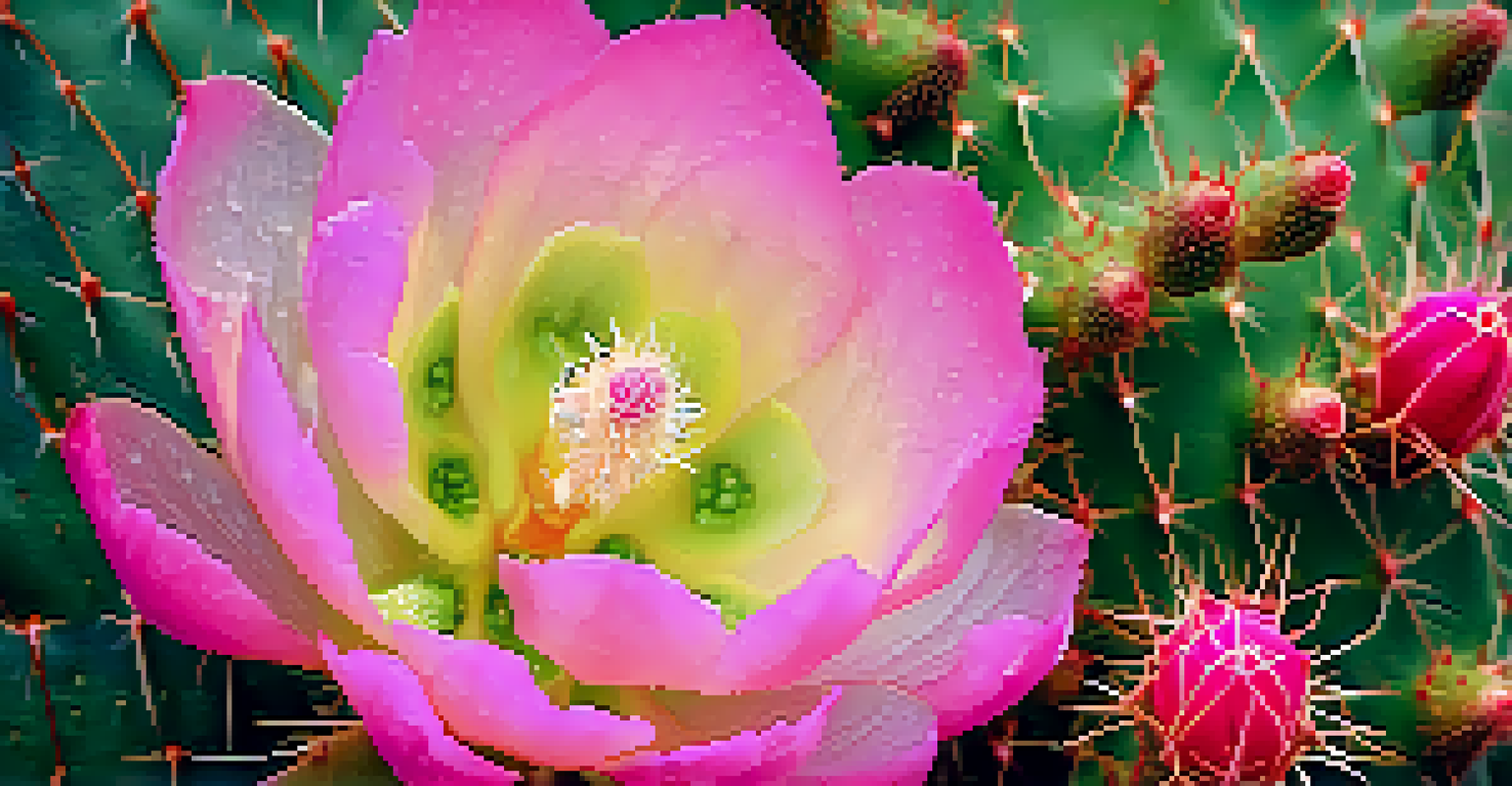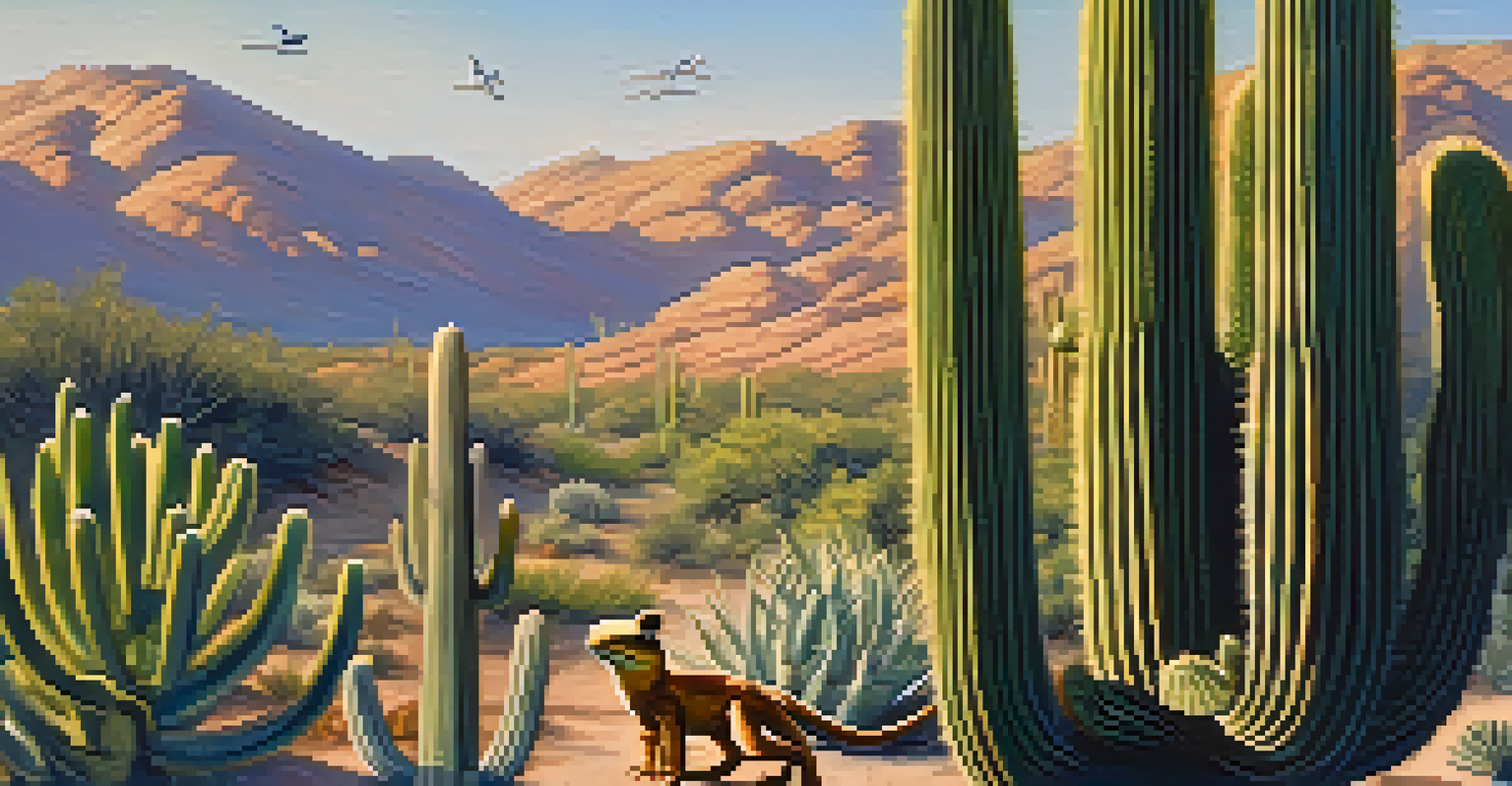The Importance of Cacti in the Sonoran Desert Ecosystem

Cacti: The Heart of the Sonoran Desert
Cacti are more than just spiky plants; they are vital components of the Sonoran Desert. These unique plants have adapted to survive in extreme conditions, making them essential for the ecosystem. Their ability to store water and thrive in arid environments allows them to support a range of life forms.
Cacti are the ultimate survivors, thriving in some of the harshest conditions on Earth.
In this desert, where rainfall is sparse and temperatures soar, cacti provide a crucial source of moisture. Animals, from insects to larger mammals, rely on cacti for hydration, especially during the hot summer months. This makes them indispensable for survival in such a harsh climate.
Moreover, cacti contribute to the desert's biodiversity. By providing food and shelter, they create a habitat for various species, from birds to reptiles. Their presence plays a significant role in maintaining the delicate balance of the ecosystem.
Water Conservation: The Cactus Advantage
One of the most remarkable features of cacti is their water conservation abilities. These plants have evolved thick, waxy skins and spines instead of leaves, which minimize water loss. This adaptation allows them to endure long periods without rain while still thriving.

During the rare rainfall events, cacti absorb and store water efficiently. This stored water is not just a lifeline for the cacti themselves but also for many animals that depend on them as a water source. In this way, cacti act as natural reservoirs in the desert.
Cacti Sustain Desert Ecosystems
Cacti are vital for hydration, food, and shelter, supporting a diverse range of wildlife in the Sonoran Desert.
The water-seeking behavior of various desert animals, such as birds and rodents, often leads them to cacti, creating a dynamic ecosystem. This relationship highlights the interconnectedness of desert life and underscores the importance of cacti in supporting diverse species.
Cacti as Food Sources in the Desert
Cacti are not only vital for hydration; they also serve as a food source for numerous desert inhabitants. Many animals, including birds, insects, and mammals, consume cactus fruits, pads, and flowers. This natural bounty is a key nutritional component for various species.
In every desert, there is a hidden oasis of life; cacti are the guardians of that oasis.
For example, the prickly pear cactus produces sweet, fleshy fruits that are not only consumed by wildlife but also harvested by humans. These fruits, known as 'tunas,' are a staple in local diets and are often used to make jams or beverages. Thus, cacti contribute significantly to both animal and human diets.
Furthermore, the flowers of cacti attract pollinators like bees and butterflies. This interaction not only supports the reproductive cycle of cacti but also promotes the overall health of the ecosystem, showcasing the intricate relationships within the desert environment.
Cacti and Their Role in Soil Health
Cacti play an essential role in maintaining soil health in the Sonoran Desert. Their root systems help to stabilize the soil, preventing erosion caused by wind and rain. This stability is crucial in a landscape where soil can easily be swept away.
Additionally, cacti contribute organic matter to the soil through their decaying parts. When cacti shed their pads or flowers, this organic material enriches the soil, enhancing its fertility. Healthy soil is vital for the growth of other plants, further promoting a thriving ecosystem.
Adaptable Survival Strategies
Cacti employ unique adaptations, such as CAM photosynthesis and deep root systems, allowing them to thrive in harsh desert conditions.
Moreover, the presence of cacti influences the soil's moisture retention capabilities. Their ability to absorb and release water helps maintain a balanced environment for other desert flora, showcasing their importance in supporting the entire ecological network.
Cacti as Shelter for Desert Wildlife
Beyond hydration and food, cacti provide critical shelter for various desert animals. The dense spines of cacti create a protective environment that offers refuge from predators and harsh weather conditions. This makes cacti a safe haven for many creatures.
Small mammals, birds, and reptiles often find shelter in the crevices of cacti. For instance, birds may nest in the arms of saguaro cacti, while lizards hide among the spines. This natural architecture plays a significant role in the survival of these species.
In addition, the shaded areas created by larger cacti help regulate temperatures for smaller inhabitants. By providing a microhabitat, cacti contribute to the overall health and diversity of desert wildlife, forming a critical part of the ecosystem.
Cacti and Climate Adaptation Strategies
Cacti are a testament to the remarkable adaptability of life in extreme environments. Their unique adaptations, such as the ability to photosynthesize at night (a process called CAM photosynthesis), allow them to thrive where most plants cannot. This strategy minimizes water loss during the day when temperatures are highest.
Moreover, different cactus species have evolved various survival strategies to cope with the harsh desert conditions. Some have developed deep root systems to access underground water, while others have adapted to grow quickly during brief rainy periods. These diverse strategies showcase the resilience of cacti.
Cultural and Economic Importance
Cacti hold significant cultural value for Indigenous communities and contribute economically through agriculture and tourism.
By understanding these adaptations, we gain insight into how life can flourish in seemingly inhospitable places. Cacti not only survive but thrive, making them a vital part of the Sonoran Desert ecosystem and a model for resilience in nature.
Cacti: A Cultural and Economic Significance
The cultural significance of cacti extends beyond their ecological role; they are deeply woven into the identity of the Sonoran Desert communities. For many Indigenous cultures, cacti are symbols of resilience and adaptability. They are often featured in art, folklore, and traditions.
Economically, cacti contribute to local economies through agriculture and tourism. The harvesting of cactus fruits and pads provides income for many families, while the unique beauty of cacti attracts tourists eager to explore the desert landscape. This economic aspect fosters a deeper appreciation for the desert's natural resources.

Furthermore, conservation efforts are increasingly focused on preserving these iconic plants. By protecting cacti and their habitats, communities not only safeguard their cultural heritage but also ensure the sustainability of the ecosystem for future generations.